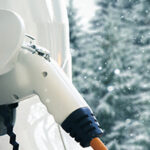-
What We DoFrom fleet management and productivity solutions to upfitting, fabrication, and insurance, Holman has the integrated automotive services expertise to keep your business moving.Overview
-
ResourcesWe have a lot to share. Browse our resources library for current insights, data, strategies, and success stories from our own experts in their respective fields.Overview
-
About UsWhen Holman was founded in 1924, we set something positive in motion. Our consistent focus on people and our commitment to integrity make us who we are today.Overview
 Join Our TeamWe’re not just in the automotive business, we’re in the people business. Join us for the ride.Browse Careers
Join Our TeamWe’re not just in the automotive business, we’re in the people business. Join us for the ride.Browse Careers
Winter Driving Tips For A Safer 2022
Holman Marketing
November 16th, 2022

Is your vehicle winter ready? Winter driving – tips for a safer 2022
Dark nights, snow, ice, floods, and fog make driving during winter tougher than at any time of the year. The UK’s professional drivers are experts at coping with the conditions and staying safe on the road, whatever the weather. However, mechanical breakdowns are a risk for every vehicle, every driver, and every operator this winter. Is your vehicle winter ready?
As well as poor weather, we’re all facing an additional challenge this year: rising energy prices. Of course, we all know that sticking to the speed limit, switching off our engines, and going a bit lighter on the right foot can cut fuel use, but there are other things we can all do to increase safety, cut costs, and lower our carbon footprint.
Holman’s expert engineers have created these 6 winter driving tips for a safer 2022.
- Check tyres
The condition and care of your tyres matter most during winter. They must be inflated to the correct pressure, and the tread must be deep enough to grip. Experts found that tyres with 6.7mm of tread were 60% more efficient than those with 1% tread in typical winter wet weather.
If you haven’t already done so, check over your tyres and use a tread depth gauge to check how much tread is left.
One question we’re often asked is: Should I buy winter tyres? Of course, it depends on where you’re driving. Winter tyres aren’t essential, but if your vehicles operate at temperatures below 7ºC, they’ll deliver a performance boost.
For most of us, an all-weather tyre is a suitable option, particularly for urban drivers who are unlikely to experience the worst weather conditions.
- Don’t idle your vehicle
Many of us start our vehicles and leave them running before driving, but there’s no need. Across the pond, American drivers regularly leave their cars idle for up to 5 minutes before driving. Modern, fuel-injected vehicles don’t need to be left to idle. You’re simply wasting fuel and increasing emissions.
Starting the car up, switching on the heater, and driving off slowly after 30-seconds is all you need to do. Leaving your car idling for too long can damage its engine.
One of the reasons many of us idle our cars is to get rid of condensation. But burning fuel is never the best way to achieve this. So instead, you can buy a dehumidifier for less than £10, which will last you several years and stop condensation from appearing.
- Consider upgrading your oil
A full synthetic or synthetic-blend engine 5W30 oil will provide greater protection and better performance during the winter. An oil change may not be cheap, but it could keep your engine running smoother for longer.
While most passenger vehicles won’t cover tens of thousands of miles each year, fleet vehicles will – so you must stay on top of maintenance. As well as an oil change, you’ll want to ensure all other fluids are topped up (see the next tip!).
- Do a weekly engine-bay check
We all know we need to top up our oil, antifreeze and all other essential fluids. But how many of us want to click the latch, lift the bonnet, and check when it’s below freezing?
We recommend building a weekly check into your regime. So whether it’s first thing Monday morning or last thing Friday night – check your vehicle over each week.
During the winter, your engine and its essential safety systems are at greater risk. Rubber seals and hoses can split as they’re exposed to extreme temperatures. Low levels of antifreeze (coolant) should ring alarm bells, and you should always have some stashed away for when you need it.
- Check your car battery health
Your 12v battery has the challenge of cranking over your engine on the coldest days. Over time, all batteries will lose some capacity, but you’ll only know how much if you test it.
You can pick up a battery tester for less than £10, and you’ll get an accurate reading on the health of your battery. You’re looking for a reading of between 13.7 to 14.7 volts when it’s attached. Any less than that, and you could benefit from a new battery. It’s not going to be cheap to replace a battery, but it’ll be more affordable than calling a breakdown service.
If you’re laying up your vehicle, consider using a trickle charger to keep your battery topped up.
- Winter survival kit
A vehicle breakdown at any time of the year is frustrating, but during winter, it can be dangerous. Therefore, we recommend that every driver creates a winter survival kit that can be stored in the boot in a plastic crate or bag.
As well as a tread depth gauge and battery tester, ensure you’ve got replacement bulbs, a red warning triangle, a fluorescent jacket and a first-aid kit. You can also add some warm clothes, disposable gloves, a torch, and some snacks and drinks.
Have a warm winter from all of us at Holman
Breaking down is never fun, but it’s worse during winter. Regular safety checks and preventative maintenance can help you head off any issues before you’re left stranded at the side of the road.
All of us at Holman wish you and your family a warm winter.
Related Resources
Explore more related industry news, insights, and developments.
It looks like you've navigated to our Holman UK website and are located outside of this region. Would you like to continue or select a different region?
✕





